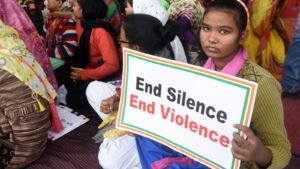
This column is on the Bihar assembly elections, but it is more of a collage of the massive changes taking place in the state and the painful impact of the upheaval.

First, let’s go back in time to the last decade of the 20th century. I, along with two colleagues, was traveling to Dhanbad from Patna. In the dim sunlight of high winter, we witnessed a disturbing scene near the road. In the bitter cold, a woman draped in a sari was about to step into a slush-filled pond to bathe. What held her back was that she didn’t seem to have another sari to wear after bathing. People in vehicles passing by were leering at her. I was trying to understand her vacillation in a dignified way, but what followed further accentuated our unease. She haltingly sat on her haunches and rinsed her mouth with the same water.
A lot of water has flowed in the Ganga and the Kosi since then. Bihar was reorganized into two states. Dhanbad is now a part of Jharkhand, while the condition of women in Bihar has undergone a sea change. Government data suggests that the twin interventions by the state government and society have helped the women take a giant leap. In the year 2000, women literacy rate in Bihar was 33%, which is now estimated at 73.91%. The 35% quota for women in state government jobs has resulted in a big improvement in the male-female ratio in the workplace. Today, 37% of the police force is women. Similarly, the absolute number of women teachers stands at 261,000. Women in Bihar are now wielding both pen and pistol.
Bihar also has 1.06 million active self-help groups. Through these, 14.5 million women are carving their individual stories of financial success. These women have availed loans totaling 15,000 crore from the banks. Their record in repaying loans — 99% — is far better than that of men. This is the reason we are now spared from the unfortunate scenes one witnessed in the 1980s and 1990s.
Women in Bihar have come a long way, and I am confident that they will vote for a better Bihar in the coming election. My confidence stems from the fact that education and financial independence have created a high level of awareness among women in Bihar. In 2015 and in 2020, 60% of women came out to vote, which indicated their emergence as a formidable vote bank. This is the reason every political party is going all out to woo them.
However, this is only one half of the story. Despite all the empowerment, their sons, husbands, sons, or some other members of the family are condemned to migrate in search of employment. All the gains of development pale into insignificance in the face of this helplessness.
The reason for the lack of jobs in Bihar is that there isn’t a single big manufacturing unit in the state. Farm size in the state is shrinking. Frequent droughts and floods are forcing a large number of farmers away from agriculture, their traditional vocation. The state can’t boast of many ongoing big infrastructure projects. Small and medium industries are in shambles. For the uninitiated, 80% of employment in the country is generated in manufacturing and infrastructure. All this means that close to 30 million people, nearly a quarter of the state population, are condemned to migrate in search of work.
So it is no surprise that employment is a hot topic in the current Bihar election campaign. Every political party is busy blaming the other and listing promises.
How the issue is affecting the Bihari youth was gauged by Hindustan correspondents who spoke with the young people who had returned to their villages for Chhath pujaLet me mention just two incidents. Their lament is a reflection of the pain of the entire Bihari youth.
Gangaram from Madhepura works in a chocolate factory in Bengaluru. We asked him why he was forced to move out of Bihar. His reply was, “There’s nothing in Bihar in terms of employment. Not a single factory. There’s no work. So we are forced to go out to earn a living and support the family. We don’t go out of our own volition. Why would we leave our home if we get work here?” Gangaram continued without bothering to hear the next question. “The moment we are old enough to earn, we leave the state. Our bonds with our family and society start weakening. We get to be back once every couple of years. When we leave, our deepest angst is for how long we will be away from our loved ones. We also don’t get any respect in other states.”
What do people want from the new government?
Sanjay Chandravanshi, who works in Mumbai, says, “Whoever forms the government should focus all their energies on creating employment opportunities in the state. If Bihar sets up factories, then Millions like me will not have to go to Delhi, Mumbai, Surat or Bengaluru. We may not get work at home, but at least we’ll be in the state.”
Will the leaders who rant about bread and employment (bread and employment) undertake a constructive approach once they win the elections? Instead of empty rhetoric, Bihar and Biharis are waiting for solutions. A long time ago, a young woman asked me in Patna, “Is it Bihar’s turn now?” The wait continues for Bihar’s moment in the sun.
Shashi Shekhar is editor-in-chief, Hindustan. The views expressed are personal





